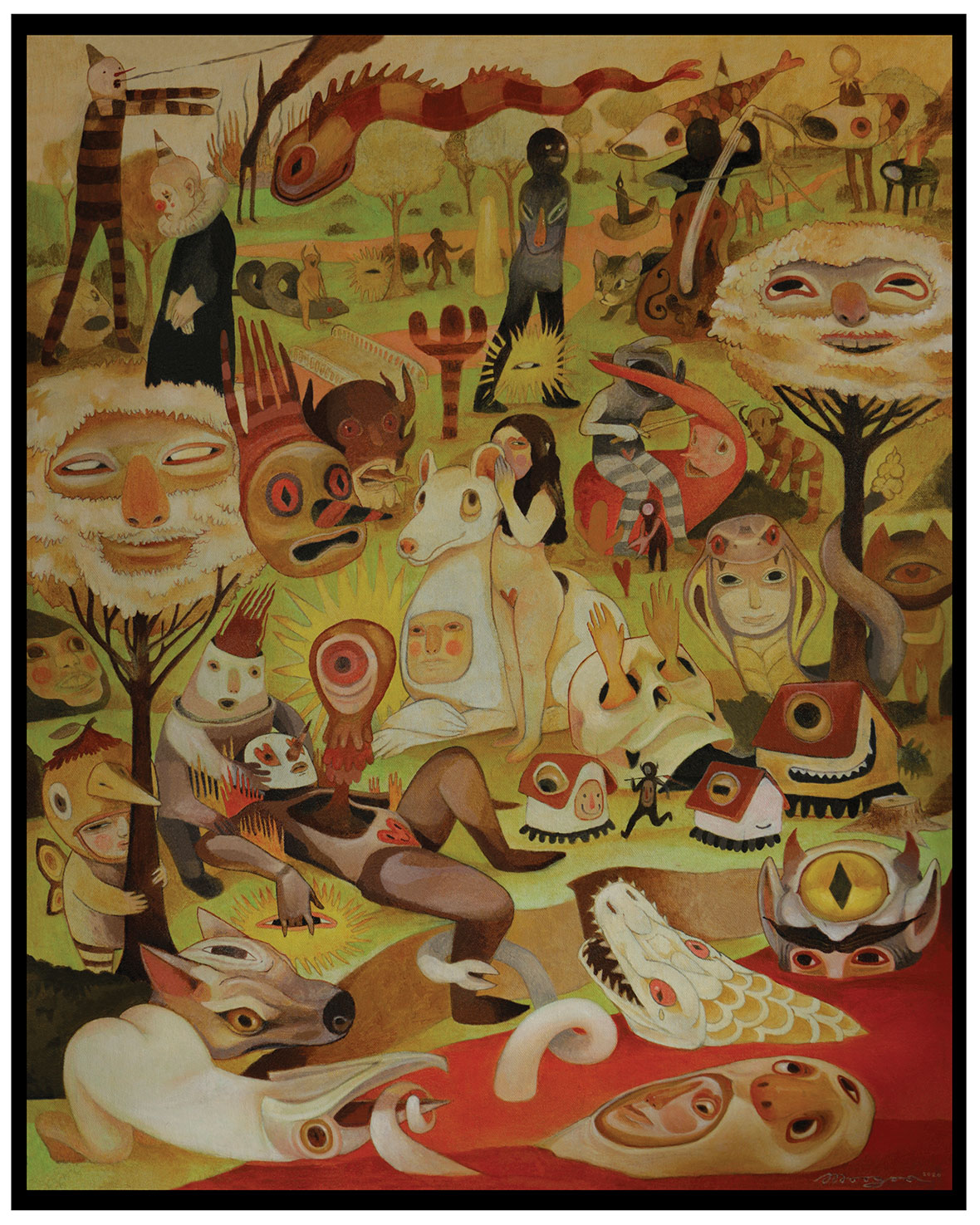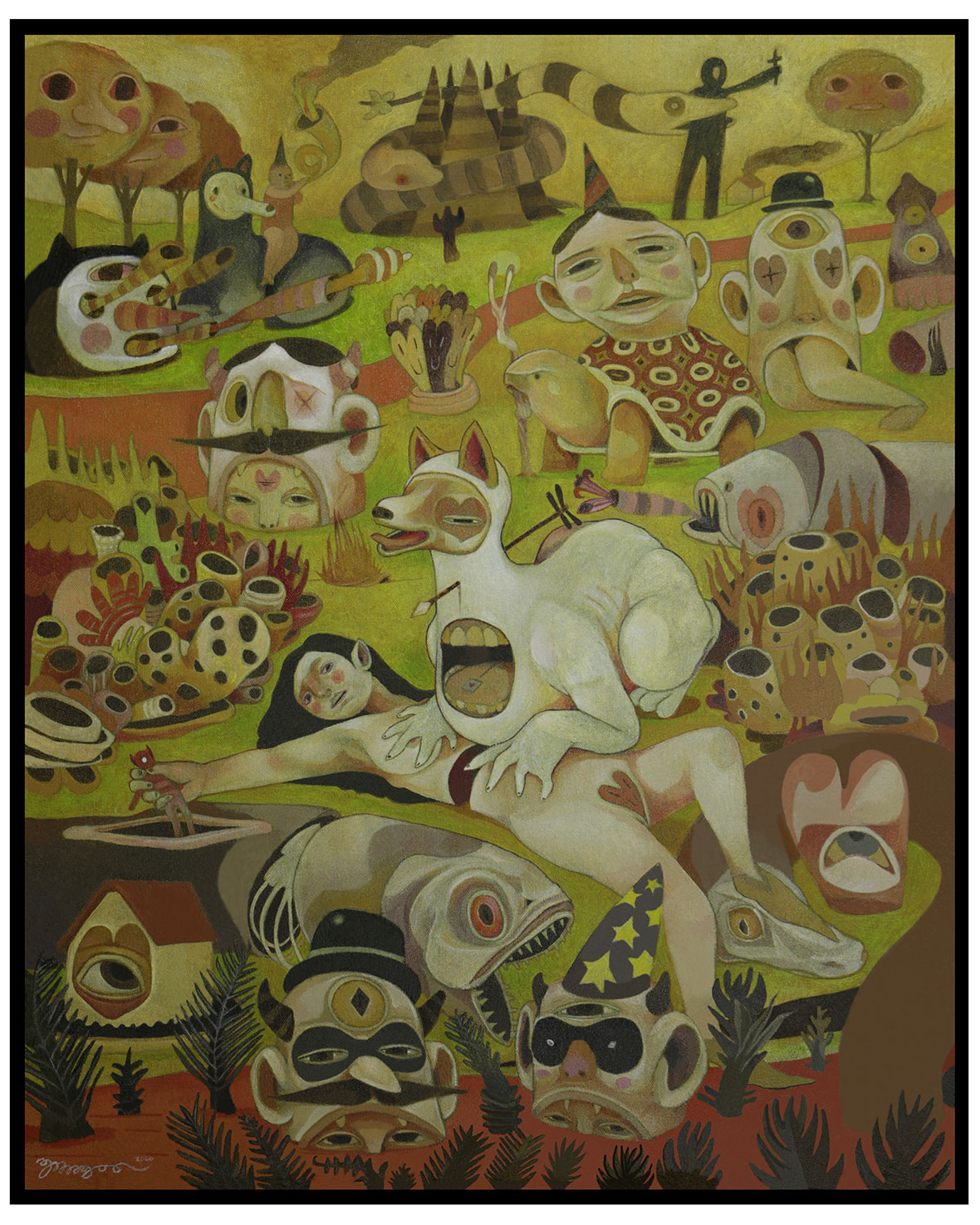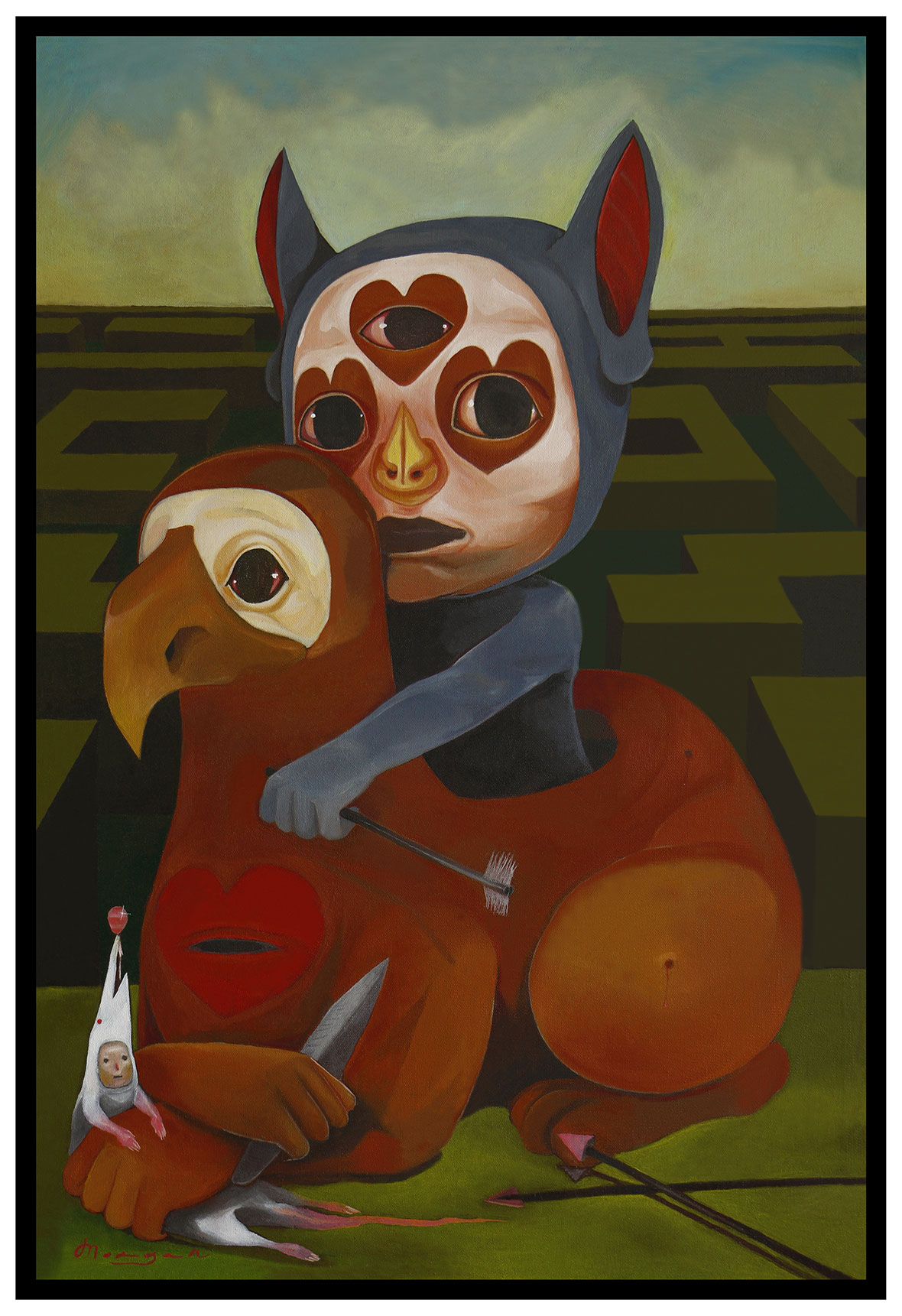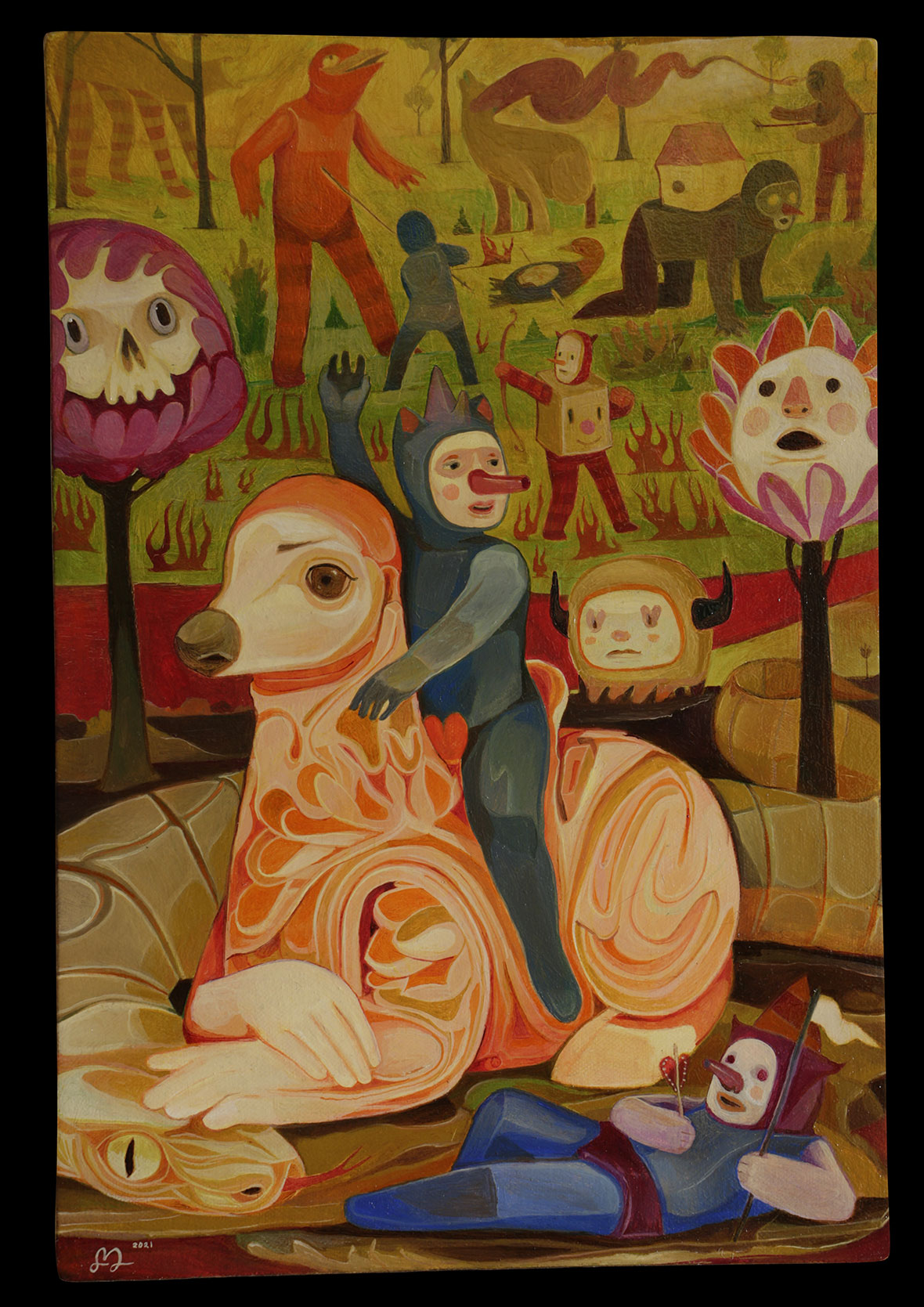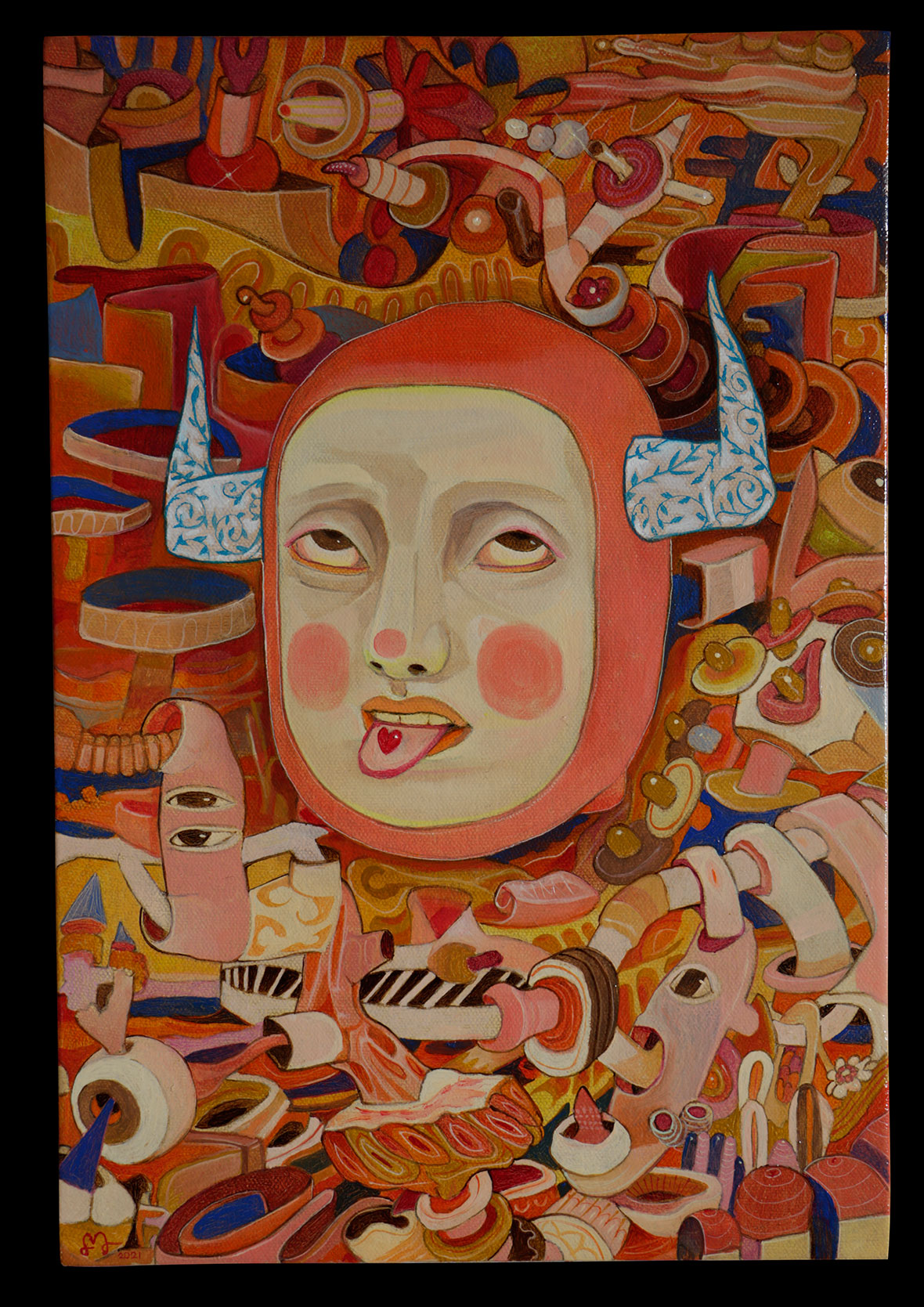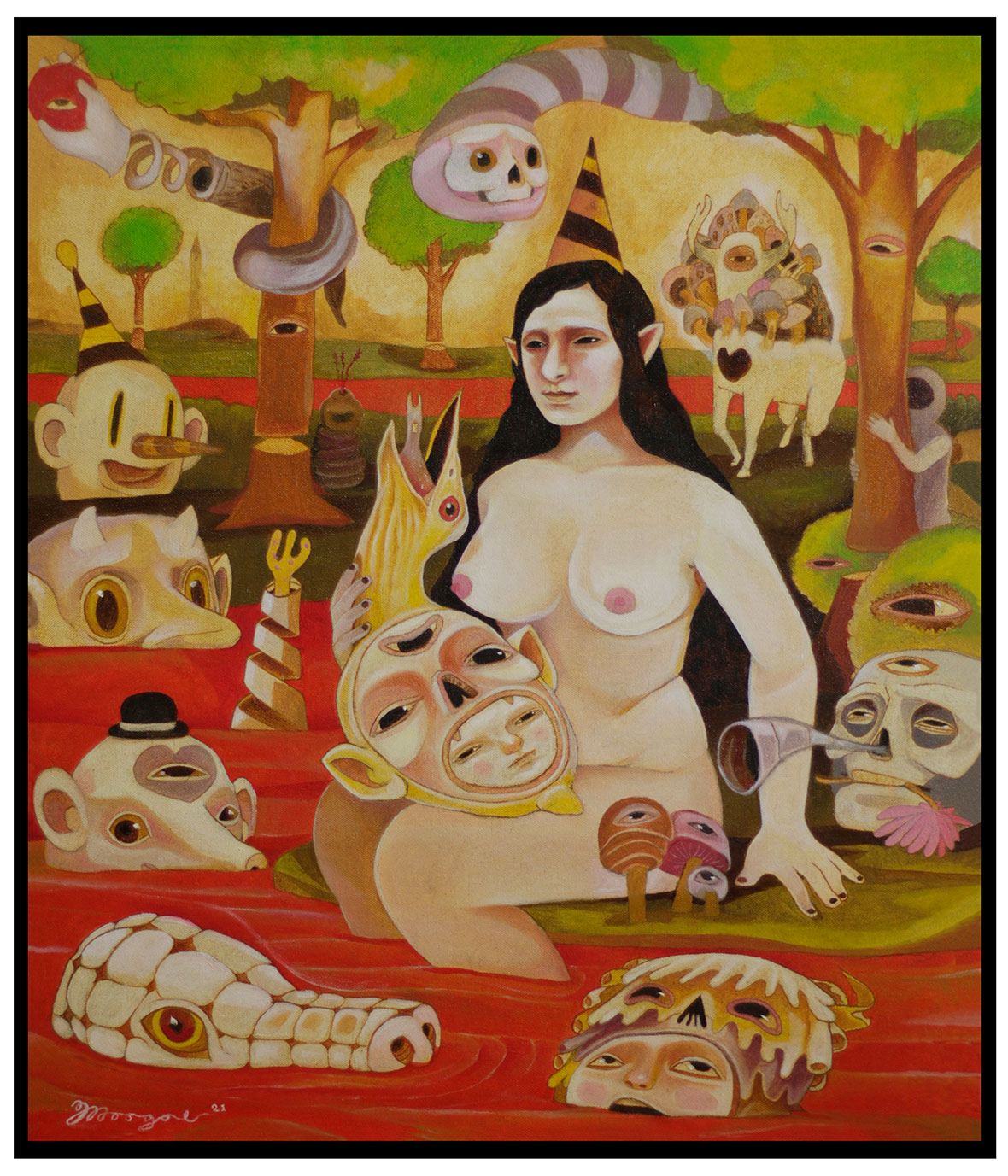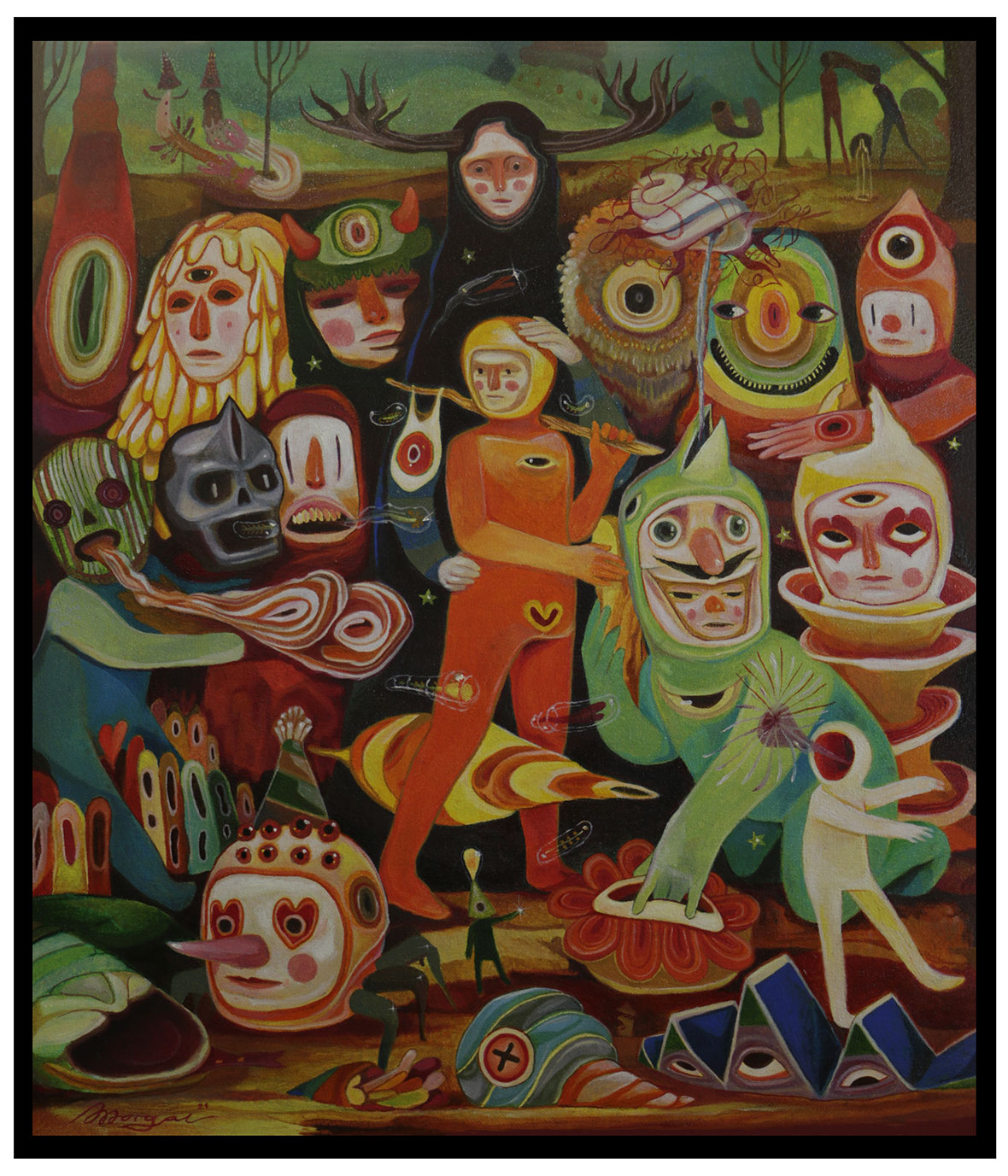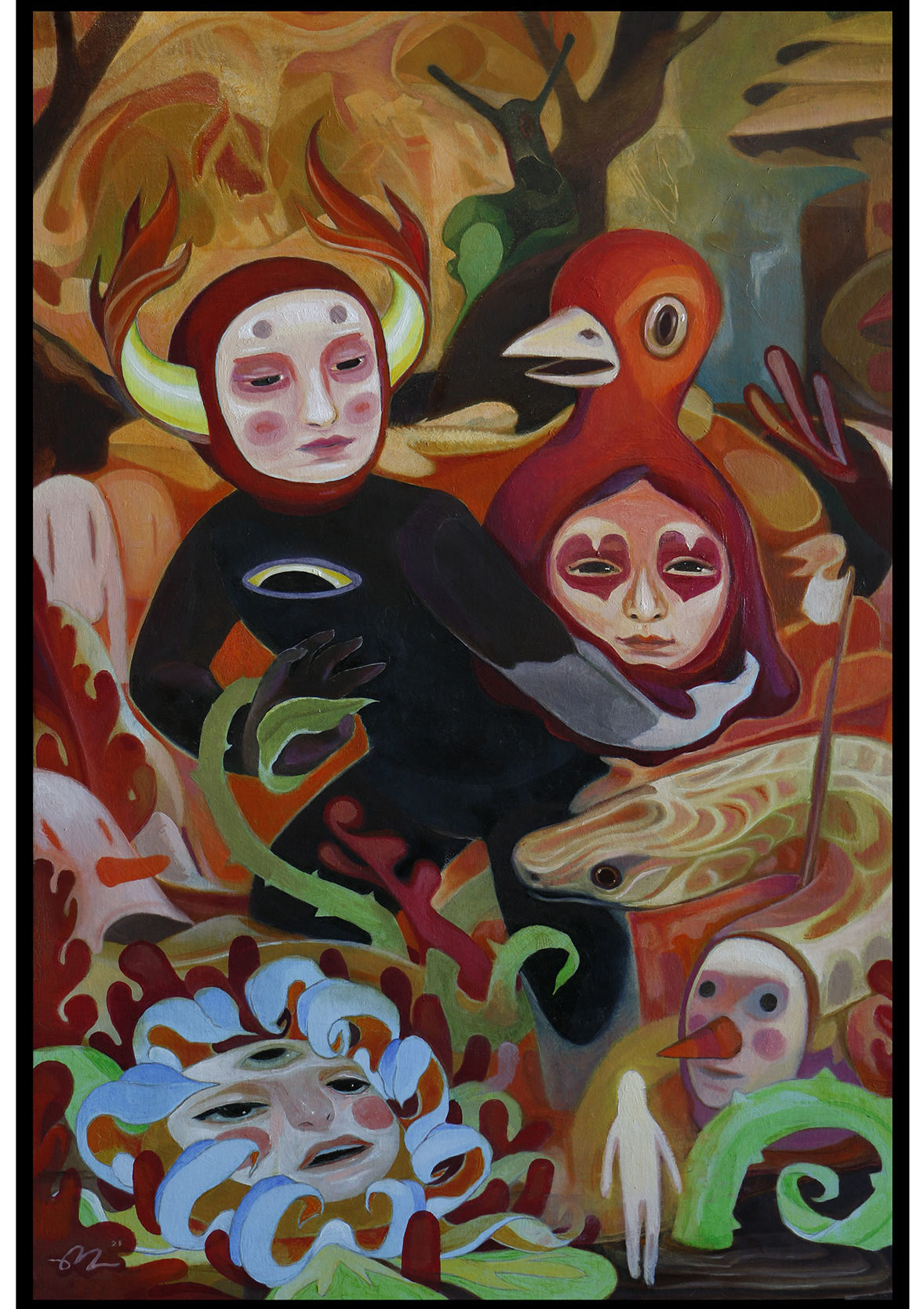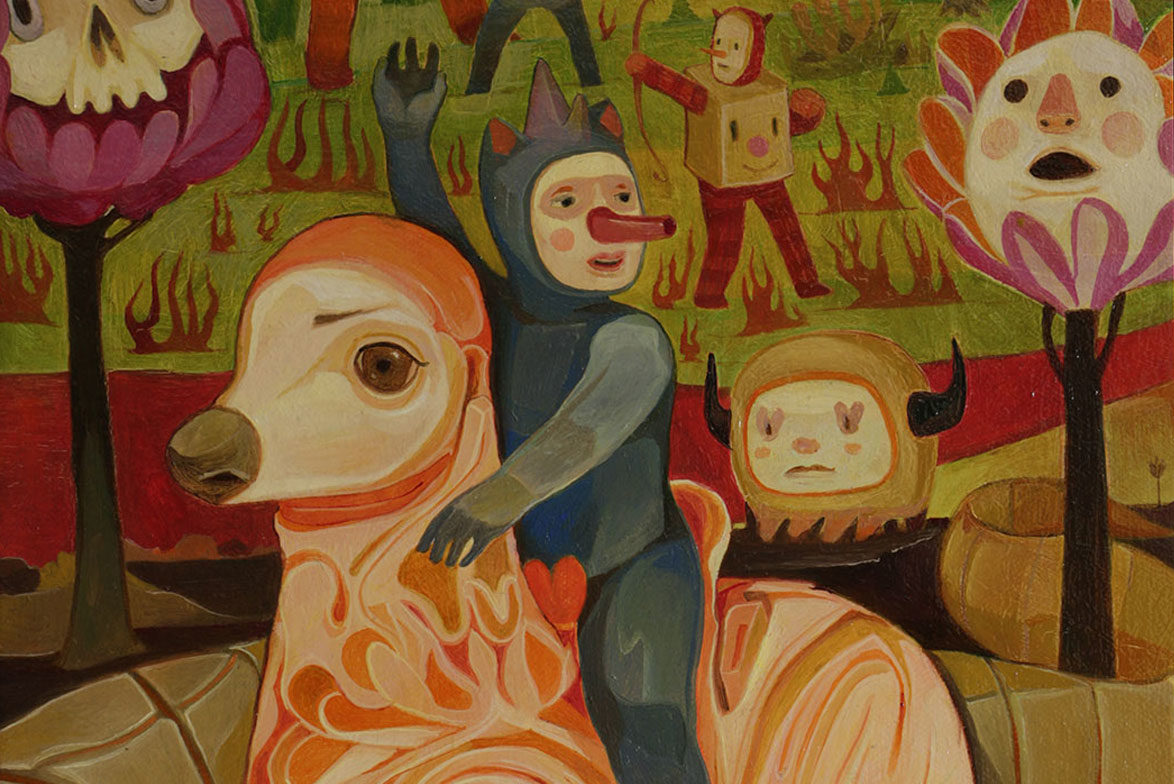
The canvases of Morgan Martinito are epics told in oil paints, populated with heroes and villains engaged in battle and travel. Recurring characters weave through dense settings full of absurd and personal iconography. Floating serpents and fiery landscapes are colored in earthy tones and rendered with comical shapes. His paintings are packed with deep meaning and playful banter. A costumed cast covered in theatrical make-up frolics and hides among vast fields, while snakes slither in the trees of bare forests and reptiles lurk in murky waters.
菲律宾艺术家 Morgan Martinito 的油画拥有史诗级作品的魅力。大量英雄和反派角色现身于他的画作,无不是在战场,或是探险的路上。这些人物与眼花缭乱的视觉元素交织在一起,由大地色系着彩,呈现荒谬不羁的风格。Morgan 让角色们换上戏袍,任凭他们在一片辽阔的田野中嬉闹;蛇和爬行动物纠缠在一起,时而漂浮于丛林,时而潜伏在一片浑水之中。这些看似不着边际的画面,其背后却充满深意和戏谑
Martinito was raised and educated in the northern cities of Metro Manila by a mother who sold fish paste in the dense street markets of Divisoria. The 32 year old wavered between fine arts and advertising during university, taking nearly a decade to graduate due to personal circumstances. He ultimately settled on a major in painting. After graduation, he experimented with clay sculptures, abstract painting, and even ran a tattoo parlor for a few years—but it would be his surrealist pop paintings that would define his creative trajectory.
Morgan 在马尼拉大都会北部的几个城市(北部共六个城市,该区域拥有优质教学资源,同时相较南部金融中心房租低廉)长大,当时母亲在 Divisoria(马尼拉的一个商业中心,该地以集市闻名)的街市上售卖鱼浆和鱼滑来补贴家用。如今 32 岁的 Morgan 曾在大学期间于艺术和广告专业之间徘徊不决,并最终决定了绘画。由于个人境遇,他花了将近十年才毕业。毕业后,他先后尝试了黏土雕塑、抽象画创作,甚至还运营了几年纹身店。直到后来,自己的创作方向才最终落在了超现实主义波普绘画上面。
After stumbling across 15th-century Dutch painter Hieronymus Bosch’s Garden of Earthly Delights on Friendster, Martinito became enamored with his style of surrealist renaissance paintings, which eventually led him to the work and lives of other Western old masters.
Much like the old masters, Martinito’s work is closely tied to Christianity, particularly Catholicism. His Kimi series is paired with poems that resemble catechisms and proverbs with direct references to Biblical characters and stories. One typical passage, appended to Kimi III: The Birth of Time, reads: “Gabriel said, We don’t have Time, the Judicator has come, wield the fire and brimstone. Kimi answered, It’s an inevitable catastrophe but we still have Time. O water my most faithful mirror unleash the wrath upon this fiend. And then suddenly flames licked the earth as it burns like a star from afar. And Time began…” Like many Filipinos, he was raised in a strict Catholic family, although he strayed from his faith in his younger years. “But life has its own surprising way of connecting us to God once again,” he says.
当多年前 Morgan 第一次在 Friendster(21 世纪初创建的社交媒体平台,后在东南亚地区大受欢迎)上看到 15 世纪荷兰画家耶罗尼米斯·博斯(Hieronymus Bosch)的画作《人间乐园》(Garden of Earthly Delights)时,他便迷上了超现实主义文艺复兴绘画风格。自那之后,他开始不知疲倦地翻阅起西方古典大师的作品和生平故事。
与许多西方古典绘画的主题类似,Morgan 也围绕基督教展开创作,这其中天主教元素尤为突出。Morgan 在一个严苛的菲律宾天主教家庭中长大,即使他在年轻的时候偏离过信仰,但他说,“生活总有它出人意料的方式,让我们与上帝再次相连。”《基米》(Kimi)系列中,作品往往配有类似宗教问答式的诗歌,以及《圣经》中的宗教人物典故。
“Gabriel:‘我们并不拥有时间,审判者已经到来,它挥舞着火焰和硫磺’;Kimi:‘灾难不可避免,但我们仍拥有时间,水啊,我最忠实的镜子,向这恶魔释放愤怒吧。’ 突然间,火焰如流星从天而降,在大地熊熊燃烧起来……”,摘自作品《基米 叁:时间的诞生》(Kimi III: The Birth of Time)配文。
The meanings embedded in Martinito’s work cover a range of topics, most of which revolve around introspection and family. The Kimi character at the center of his work is the embodiment of his real-life romantic partner and was first introduced in a painting titled Kimi, The Pinnacle of Happiness. In it, Kimi sits at the center of the composition like the enigmatic Mona Lisa. “Kimi is my partner in life, my confidant,” he says. “She who has no equal, she who always listens, she who wept with me, and endured with me. She aided me to change into the person that I aim to be. Through her, God smiled at me once again.”
Martinito explains that the series is a reimagining of the experiences he went through when he left his home after the death of his mother in 2019. For example, the burning pelican carrying an ouroboros in its talons symbolizes the delivery of a rebirth. Other iconography in the Kimi series includes horns, antennas, and spikes that reference his Taurus zodiac sign; houses, which speak to his internal thoughts and desires; and chrysanthemum flowers, which represent love, longevity, and joy. He also appeals to his sister, trying to win over her appreciation with the frequent use of hearts, which are her favorite shape.
此外,Morgan 在作品还包涵了诸多具有深度的议题,大部分关乎内省和家庭。他将作品核心人物基米(Kimi)视作是现实生活中形影不离的伴侣,向观众抛开一个又一个话题。在关于该人物的第一幅作品《基米:幸福之巅》(Kimi, The Pinnacle of Happiness)中,基米就坐在构图中心,如同蒙娜丽莎一般神秘。
Morgan 说:“基米是我的生活伴侣、我的知己,她懂得倾听。我们感同身受,一起承受着周遭。在她的帮助下,我成就了绘画上的造诣;也是通过她,上帝再次向我微笑。”
Morgan 进一步阐释人物基米的由来:2019 年母亲去世后,他漂泊在外。正是籍由这个创作中虚构的人物,让 Morgan 一点点拾起过去的记忆,一点点在创作中剖析自己。渐渐地,他在画中融入自己的个性,他用鹈鹕抓蛇的场景,象征重生和降临;以犄角、天线和尖刺,意象自己的金牛座属性;用菊花代表爱情、长寿和欢乐;房子,坦述思想和欲望;以妹妹最爱的心形图案,实现作品与家人的对话。这些共构他对于世界的理解,编绘关于自己的图腾。
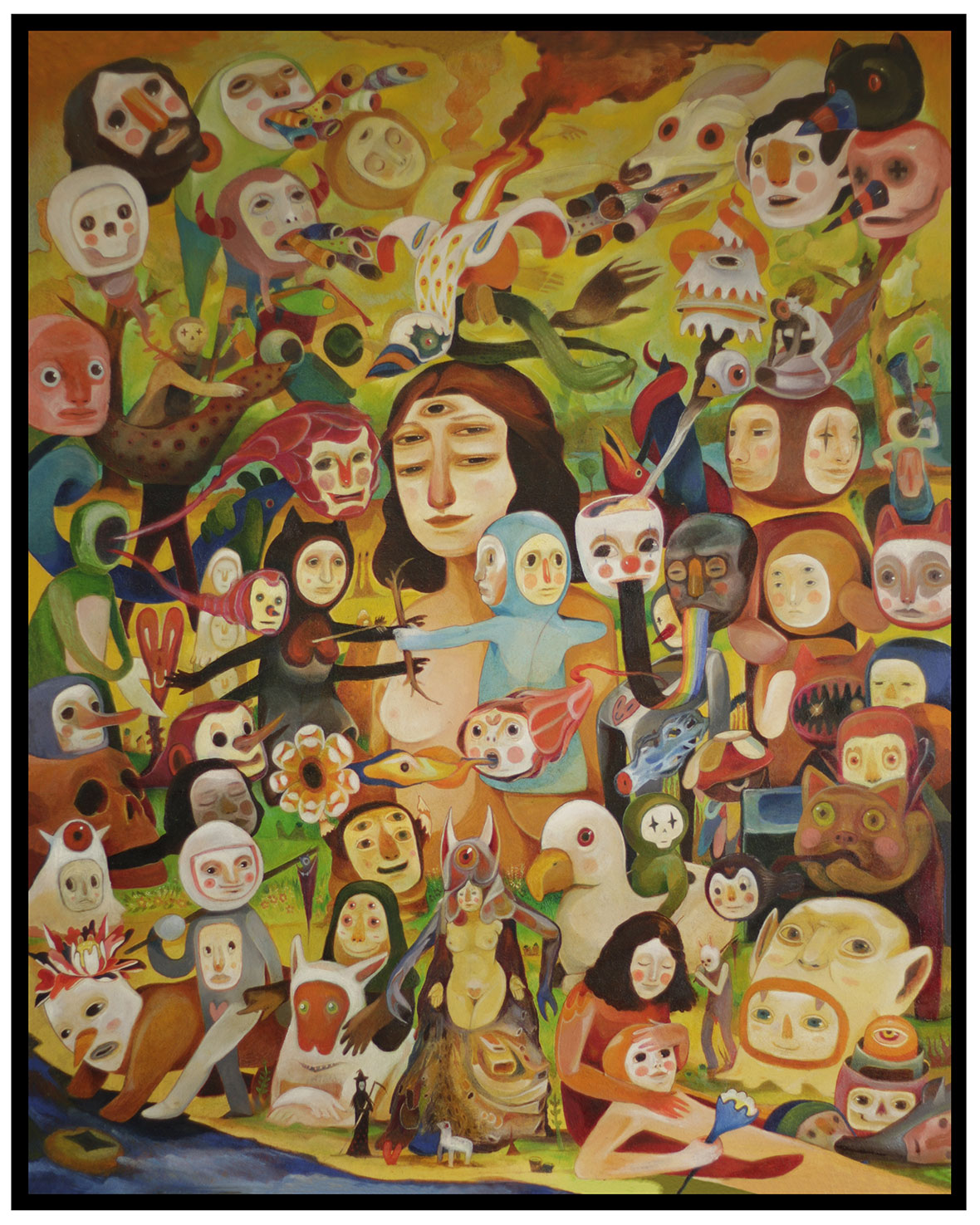
There are numerous references to his name, including the birds (Martinito translates into “small bird”) and bodies of water (Morgan means “at the end of the sea” or “sea-born”). His self portrait appears regularly as well. The drifter in Kimi V, She Who Has No Equal at the End of the Sea represents him leaving home with only a few of his belongings. He’s depicted as an orange man with a bag at the end of a stick, hobo style. His self portrait also appears throughout the series as the recurring villain, which is his way of embracing his own failings as a person: “I came across a quote that says, ‘As a child we admire heroes, but as adults we understand villains,’” he explains. “All the trials that I have experienced shaped the core of my existence.”
Morgan 还将自己名字的衍生出意象运用在作品中。他的姓氏 “Martinito” 在当地是“鸟”的意思;而名字 “Morgan” 则与海水息息相关,表达 “在大海尽头” 或 “来自海洋” 的意思,这些统统在作品中体现出来。
他的自画像也经常出现在作品中。作品《基米 伍:无与伦比的她在大海尽头》(Kimi V, She Who Has No Equal at the End of the Sea)中流浪汉的形象,映射母亲去世后那段背井离乡的经历。画面中的他是一个挑着扁担的橙色男人,一副潦倒囧态。有时,他又以坏蛋的形象出现在画中,以自嘲的姿态来揭示生活中失败的事实。他说,“我曾看到过这样一句话:小孩子崇拜英雄,成年人则能理解反派。人活在世上,就是要不断地去尝试,去寻找存在的价值。”
For Martinito, none of this context need to be fully understood by the viewer. He knows his iconography-packed canvases might seem absurd for audiences and could be interpreted in different way. But he hopes it still has a universal appeal due to the work’s vibrancy and sense of humor. “I find joy in creating something far from reality, something absurd. But colors and shapes are universal.”
对于 Morgan 本人来说,观众无需理解这些创作背景,他们或许觉得荒谬滑稽,或许对作品有着全然不同的理解。不过 Morgan 还是希望通过作品中的活力和幽默,呈现出一种普世的魅力:“颜色和形状是世界共同的语言,而真正让我乐在其中的则是超现实、荒谬的绘画方式。”
Like our stories? Follow us on Facebook and Instagram.
Instagram: @theunnaturalselectionofmorgan
Contributor: Mike Steyels
Chinese Translation: Yang Young

